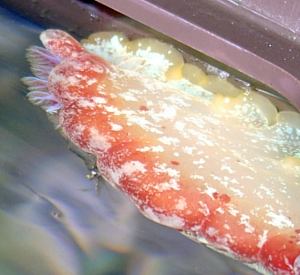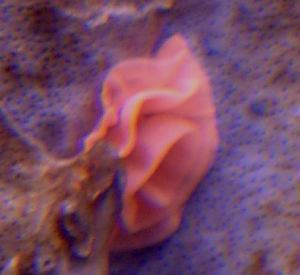Spanish Dancer - What can we feed it?
November 18, 2002
From: Shawn Elston


I purchased a Spanish Dancer from a local pet shop in Hawaii not knowing too much about it. I have had it for a few days it seem to be doing fine. It has laid eggs on one of the corals. I do not want to disturb the eggs although I do not want to have them die after hatching. All that I have read up to now mainly states that the Hexabranchus sanguineus ( Which I believe I have) eats only sponges which I due not have in the tank and have not found in any stores to buy although some do carry them but are out of stock. I am a novice aquariist and care very much for the fish I have. Please inform me of what I should do. The Spanish Dancer is a lite red color/pink with some white, about 4-6inches long has, 4-5 sets of gills that i have counted it swims in the wave like motion.
Thanks for any help you can give.
Shawn Elston
sluff37072@aol.com
Dear Shawn,
Sorry but I can't give you good news. The biggest problem is that aquarium/pet shops should NOT stock nudibranchs unless they know precisely what the species they have eats, and have a ready supply of the food available. Imagine the outcry if they could not provide the right food for all the fish they sell. By stocking nudibranchs and selling them to customers, they are essentially condemning them to starvation and death. They are also ripping off their customers as well by selling you animals they know will die.
Have a look at some of the earlier messages on Hexabranchus, which are attached below yours on the Hexabranchus page [see also Page 2]. You will see they do eat a variety of sponges, but even if you went out on a reef and collected some sponges yourself, there is no easy way for you to identify if any of the sponges you have found are ones that the nudibranch eats. There would also be the difficult job of getting the sponges back to your aquarium alive and healthy, and then the job of keeping them alive in your aquarium while they are being eaten. Concerning the egg mass. Laying eggs is not necessarily a sign of well-being, in fact often it seems to be a sign of stress. Will the eggs hatch? Sometimes, especially when stressed, the eggs are infertile. Even if fertile, Hexabranchus produces free-swimming planktonic veliger larvae, which need to swim for some time in the plankton, feeding on microscopic plants. Such veligers rarely survive in normal aquarum setups. And since the larvae settle on their food when they are ready to become slugs, we are back to the food problem.
Sorry I can't give you better news,
Bill Rudman
Related messages
-
Chromodoris or Hypselodoris?
From: Franco De Lorenzi, March 26, 2010 -
Washed up in north-western Australia
From: Sean Houlihan, February 23, 2010 -
Hexabranchus sanguineus from sthn Queensland
From: Gary Cobb, September 25, 2009 -
Juvenile Hexabranchus sanguineus from Reunion Island
From: Sully Bachel, May 8, 2009 -
Hexabranchus sanguineus from Maui, Hawaii
From: Chris Ryu, February 11, 2008 -
The secret life on Hexabranchus sanguineus
From: David Mullins, December 5, 2007 -
Hexabranchus sanguineus or Djibouti Giant?
From: Edward Dixon, September 17, 2007 -
Feeding Hexabranchus sanguineus from Tofo, Mozambique
From: Natasja Vandeperre, August 24, 2007 -
Re: Hexabranchus sanguineus video
From: Diane Hennelly, August 16, 2007 -
Hexabranchus sanguineus from Mozambique [2]
From: Natasja Vandeperre, August 11, 2007 -
Hexabranchus sanguineus from Mozambique [1]
From: Natasja Vandeperre, August 11, 2007 -
Spanish Dancer from Sydney
From: Donald Miles, July 11, 2007 -
Re: Nudibranch from the Seychelles, Indian Ocean
From: Jen Jenny, May 4, 2007 -
Nudibranch from the Seychelles, Indian Ocean
From: Jen Jenny, April 27, 2007 -
Hexabranchus sanguineus from Bali
From: Asther Lau, April 13, 2007 -
Hexabranchus behaviour
From: Sandrine Flodrops, December 4, 2006 -
Juvenile Hexabranchus from nthn New South Wales
From: Roxanne Fea, November 8, 2006 -
Re: Dancing 'Spanish Dancer'
From: Kamal El Tawil, September 1, 2006 -
Dancing 'Spanish Dancer'
From: Joseph De Vroe, August 25, 2006 -
Hexabranchus sanguineus from Indonesia
From: Kevin Lee, August 7, 2006 -
Re: Spanish Dancer Research Paper
From: Molly Ogden, July 29, 2006 -
Could this be a Spanish Dancer?
From: Brian Francisco, March 3, 2006 -
Kissing Hexabranchus sanguineus
From: Joseph De Vroe, November 8, 2005 -
Hexabranchus sanguineus with one gill
From: Joseph De Vroe, November 4, 2005 -
Mating Hexabranchus sanguineus
From: R. Grooters & M. Snoek, September 21, 2005 -
Re: Juvenile Hexabranchus
From: Colin Ogden, September 3, 2005 -
Juvenile Hexabranchus strikes again
From: Colin Ogden, September 2, 2005 -
Re: Hexabranchus sanguineus from Egypt
From: Kamal El Tawil, July 11, 2005 -
Hexabranchus sanguineus from Madagascar
From: Marco Angelozzi, July 4, 2005 -
Re: Hexabranchus sanguineus from Egypt
From: Kamal El Tawil, June 24, 2005 -
Hexabranchus sanguineus (Spanish dancer) from Egypt
From: Kamal El Tawil, June 7, 2005 -
Re: Hexabranchus juvenile from the GBR
From: Nils Anthes, January 15, 2004 -
Hexabranchus juvenile from the GBR
From: Nils Anthes, January 10, 2004 -
Hexabranchus sanguineus unrolling the mantle
From: Erwin Koehler, December 16, 2003 -
Gills on Hexabranchus sanguineus
From: Gary Cobb, December 11, 2003 -
Juvenile Hexabranchus
From: Roberto Sozzani, May 19, 2003 -
Hexabranchus from Myanmar
From: Mary Jane Adams, May 2, 2003 -
Spanish Dancer Research Paper
From: Molly Ogden, April 29, 2003 -
Hexabranchus mating photos
From: Bill Rudman, March 4, 2003 -
Hexabranchus sanguineus from Lord Howe Island
From: W.B. Rudman, January 23, 2003 -
Hexabranchus juvenile from Bali
From: Danny Van Belle, January 9, 2003 -
Re: Hexabranchus - its common name
From: Constantine Mifsud, September 9, 2002 -
Hexabranchus - its common name
From: Jason Lewis, September 7, 2002 -
Size of Hexabranchus
From: Valeria Safonova, June 22, 2002 -
Juvenile Hexabranchus sanguineus from Christmas Id
From: W.B. Rudman, May 10, 2002 -
Juvenile Hexabranchus sanguineus
From: Mary Jane Adams, May 9, 2002 -
Hexabranchus sanguineus from the Red Sea
From: Marina Poddubetskaia , April 17, 2002 -
A report on the Spanish Dancer
From: Student, March 22, 2002 -
Hexabranchus sanguineus from Bali
From: Stuart Hutchison, March 21, 2002 -
Hexabranchus sanguineus - oral tentacles
From: Stuart Hutchison, March 21, 2002 -
Are these Spanish Dancers?
From: Reine, January 27, 2002 -
Hexabranchus? from South Africa
From: Allan Connell, December 17, 2001 -
Spanish Dancer?
From: Joyce Zwiener, December 14, 2001 -
Spanish Dancer
From: Belinda, September 7, 2001 -
Swimming Hexabranchus from the Red Sea
From: Luigi Montevecchi, August 28, 2001 -
Eggs of Hexabranchus sanguineus
From: Luigi Montevecchi, August 28, 2001 -
Re: Hexabranchus 'aureomarginatus' in Hawaii
From: John Hoover, August 3, 2001 -
Juvenile Hexabranchus from Hawaii
From: Scott Johnson, July 30, 2001 -
Hexabranchus 'aureomarginatus' from Hawaii
From: Scott Johnson, July 30, 2001 -
Hexabranchus 'pulchellus' from Hawaii
From: Scott Johnson, July 30, 2001
